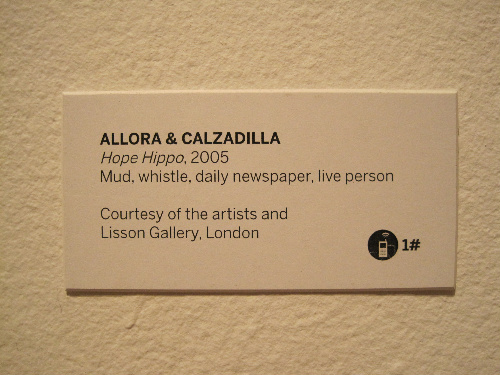
Hope Hippo
We talk a lot about community engagement and the arts, but how does a museum truly engage a viewer beyond just hanging the art up on the wall and opening the door and saying “come in.” I recently had a visual art experience that went well beyond the tradition model of museum – viewer interaction. I became a named element in an artwork.
The new show at the Aspen Art Museum, entitled “Restless Empathy“, invited community members to participate in an artwork. Individuals were invited to sign up for an hour, show up and sit on top of the hippopotamus sculpture made of mud and read the newspaper. When you found something disturbing in the newspaper you blew a whistle , one short blast. You were not to make eye contact with the patrons or speak to them. You became a significant part of the work. Above is a video clip of my experience with the work.
Heidi Zuckerman Jacobson, director and chief curator of the Aspen Art Museum, explained the exhibit in her catalogue essay accompanying the show: “Allora & Calzadilla’s work Hope Hippo (2005) was originally commissioned for the 51st Venice Biennale. The work in part responds to the literary and touristic image ofVenice as an origin point of humanism. Animals serve a variety of allegorical functions in sculptures around Venice, including Andrea del Verrocchio’s equestrian monument to the mercenary general Bartolomeo Colleoni. The artists explain, “In place of a war-horse whose stature is meant to mirror the erect, belligerent body of its human master, [we] summon its monstrous etymological cousin [the] Hippopotamus or ‘river-horse,’ from the dregs of the lagoon.” In contrast to the elevated, enduring materials of classical sculpture, such as marble and bronze, Allora & Calzadilla’s creature is created from a natural, “base” material: river mud. The creature’s existence is thus finite and vulnerable to the ruinous forces of nature. A volunteer sits atop the hippo at all times, reading a daily newspaper of his or her own choosing. When the sitter reads something believed to be an injustice of any kind, the volunteer blows a whistle. As one person’s injustice is another person’s truth, Hope Hippo plays upon the variegated values held by different members of our society.” We hear a lot about using digital media to curate your own art experience, but here is a wonderful example of the ultimate low tech personal curatorial experience. You as the participant choose to sit on a hippo made of mud, read your newspaper and blow your whistle , or not – you are part of the work, recognized as such in the wall text and the essay about the piece. You are not a viewer of the work , but instead a viewer of society. The opportunity for the museum-goer to “curate his own experience” and create social interaction instead of the traditional one to one relationship between the viewer and the art is bubbling up all over the contemporary art world and reflects the expectations of a society that has been raised in an option driven digital age.
Recent Content
-
Artsarticle ·
-
Artsarticle ·
-
Artsarticle ·

